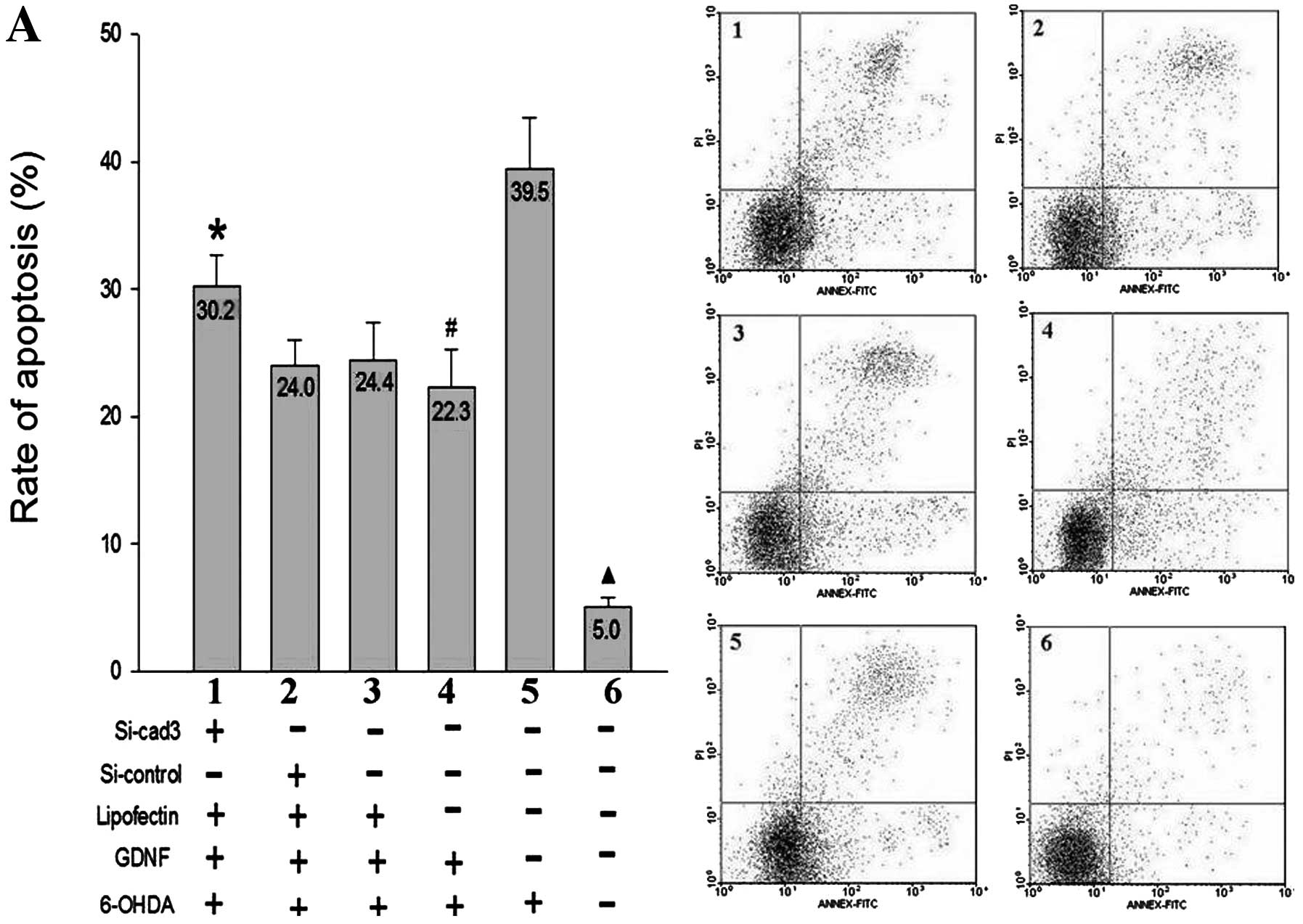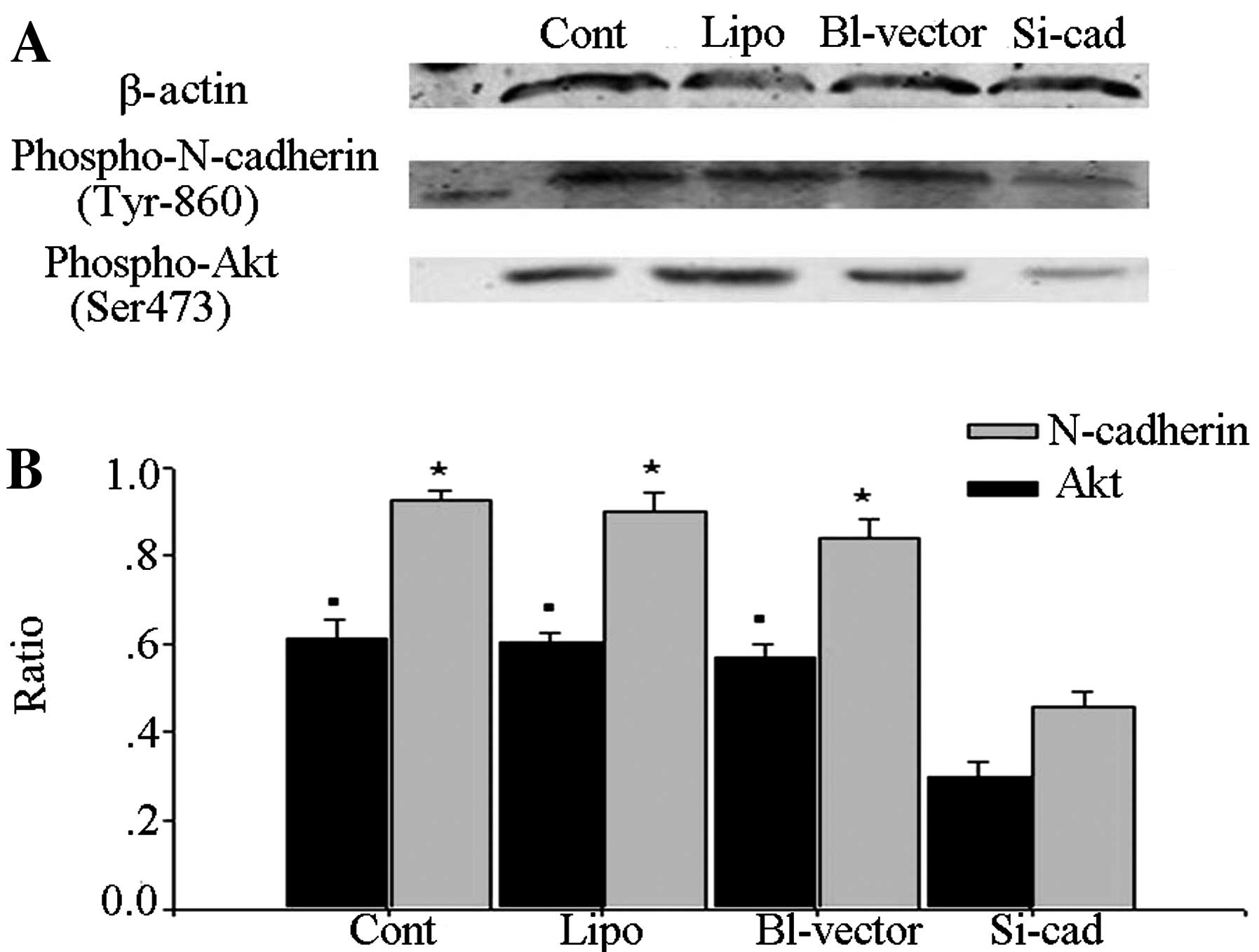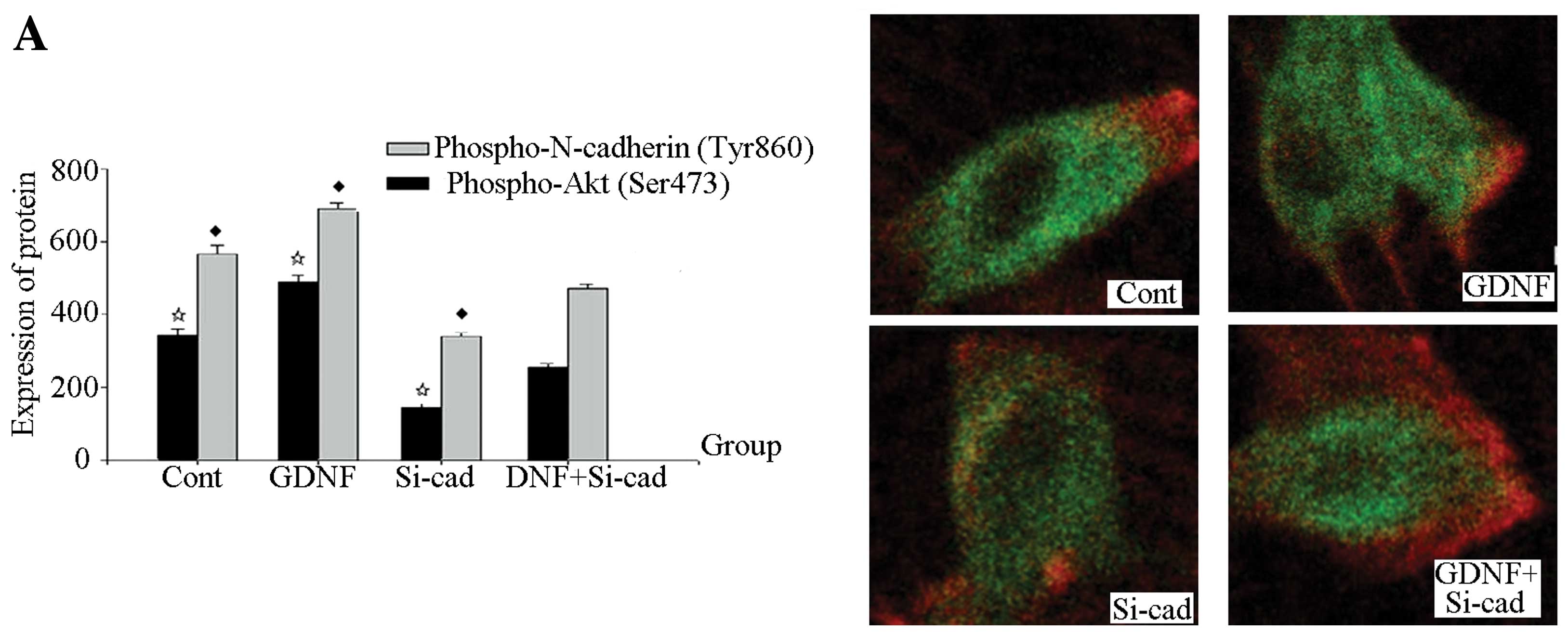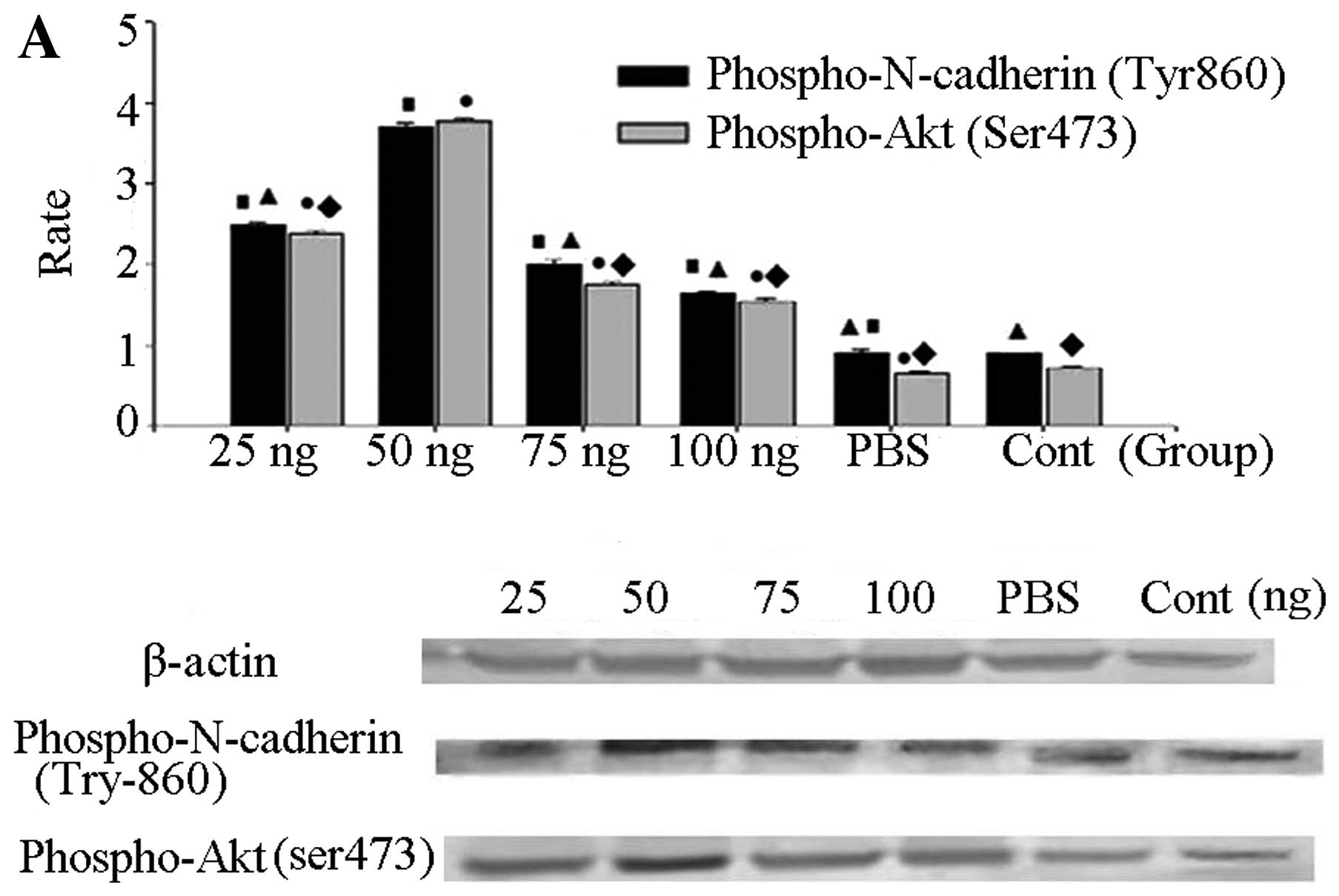Involvement of N-cadherin in the protective effect of glial cell line-derived neurotrophic factor on dopaminergic neuron damage
- Authors:
- Published online on: January 3, 2013 https://doi.org/10.3892/ijmm.2013.1226
- Pages: 561-568
Abstract
Introduction
Parkinson’s disease (PD) is a degenerative disease of the central nervous system that severely endangers human health. Recently, it has been shown that the main pathological change associated with PD is the denaturing death of dopaminergic neurons (DAs) in the mesencephalon substantia nigra compact of patients.
Lin et al (1) first isolated and purified glial cell line-derived neurotrophic factor (GDNF) in 1993 and found that GDNF exhibited neurotrophic effects on DAs of cultured embryonic mesencephalons, as well as stimulated the survival and differentiation of DAs in the ventral mesencephalon of mammals (1,2).
In order to realize the protective effect of GDNF on DAs, the specific intercellular signaling pathway must be activated by its membrane receptor. Driven by this signaling pathway, the cytoplasmic transcriptional molecules and substances enter into the nucleus, thus exerting influences on the expression of related genes of certain substances, conferring protection and aiding in the survival of the cell. The composition of the GDNF membrane receptor system is relatively clear. It is mainly composed of two parts: the ligand binding receptor GDNF family receptor α1 (GFRα1); the known transmembrane signal transduction receptor Ret (3,4), NCAM140 (5) and integrin β1 (6–8).
During the protection of DAs via GDNF, the main activated intracellular signaling pathway was found to be the PI3K/Akt pathway (9). Studies have shown that the mechanisms involved in the activation of PI3K by GDNF occur as follows. After GDNF binds to GFRα1, the RET kinase is activated by phosphorylation of its intracellular portion, thus activating the PI3K/Akt pathway (10). GDNF can phosphorylate the intracellular ‘adaptor protein’ Fyn via NCAM, thus activating the PI3K/Akt pathway (11); and GDNF can activate the PI3K/Akt pathway via integrin β1 and the ‘adaptor protein’ Shc (12). Therefore, it is clear that GDNF can directly or indirectly activate PI3K/Akt via a transmembrane receptor to protect DAs.
N-cadherin is a transmembrane adhesive protein. Its cytoplasmic region can interact with intercellular proteins of various scopes (13–15). It is well known that N-cadherin shares a similar structure and function to NCAM and integrin β1, which can also mediate adhesion and signal transduction (16). The extracellular portion of Ret that binds to GDNF/GFRα1 has a cadherin-like domain as well (17). Our previous, and unpublished data, demonstrated that N-cadherin binds to GDNF (18,19). Thus, there is an urgent need to confirm that GDNF also activates the PI3K/Akt signaling pathway via N-cadherin, in order to confer a protective effect on DAs. This knowledge will contribute to the development of treatment strategies for PD.
In order to verify the above concepts, in the present study, the N-cadherin gene were knocked down. Using flow cytometry (FCM) and Hoechst 33258 staining, we confirmed the protective effect of GDNF on DAs. In addition, through immunoblotting and immunohistochemical staining, we demonstrated the PI3K/Akt signaling pathway was activated following inhibition of N-cadherin expression, and we examined the phosphorylation levels and the correlation of phosphorylation between N-cadherin and Akt following treatment with GDNF.
Materials and methods
Ethics statement
Adult male Sprague-Dawley (SD) rats were provided by the Experimental Animal Center of Xuzhou Medical College. This research was approved by the Experimentation Committee of Xuzhou Medical College, and all animals were treated according to the national and international rules of animal welfare. For the present study, there were no suitable alternative approaches, and care was taken to minimize animal distress.
Cell lines
The MN9D cell line was kindly provided by Professor Qunyuan Xu from Capital Medical University. The cryopreserved MN9D cells were thawed and cultured in a flask for 3 days. The cultured cells were digested and then re-suspended with DMEM/F12 (Sigma-Aldrich) plus 10% FBS and 1% B27 (Gibco), transferred to a 6-well cell culture plate that was pre-coated with polylysine (Sigma-Aldrich), and cultured at the density of 2–5×105/well. The plate was kept at 37°C in 5% CO2, in a moisture balanced standard incubator for culture. After a 24-h culture, the serum containing DMEM/F12 was replaced by serum-free culture medium, Neurobasal™ medium (Gibco) containing 2% B27 and 4 mM glutamine.
N-cadherin RNAi
MN9D cells were transiently transfected with a control vector and an N-cadherin gene-specific interfering plasmid using Lipofectamine 2000 transfection reagent (Invitrogen) according to the manufacturer’s protocol. Changes in N-cadherin expression were evaluated 3–4 days post siRNA transfection. Stable N-cadherin-knockdown MN9D cells were used for immunoblotting and immunocytochemistry assays.
Stereotaxic injection at the substantia nigra of the rat lateral cerebral ventricle
The stereotactic instrument was calibrated, the weighed animal was intraperitoneally injected with 360 mg/kg of a chloral hydrate solution, the head was immobilized and sheared, and the skin of the head was sterilized with 2% iodine and 75% alcohol. A 6-cm incision was cut along the sagittal suture, the fascia and muscles were stripped and the periosteum was separated to expose the sutura. The skull was cleaned with 30% hydrogen peroxide, and the point of bleeding on the skull was immediately stanched with bone wax. The stereoscopic position was determined according to the rat brain atlas (Paxinos G and Watson C: The Rat Brain in Stereotaxic Coordinates, 2nd edition, Academic Press, Inc.). The insertion of the needle was marked on the skull with locating pins referring to the median line, anterior and posterior fontanels. The injection needle was fixed and inserted into the brain according to the stereoscopic location coordinate. The injection was then conducted.
Immunocytochemistry
MN9D cells were inoculated in a 24-well plate (to allow cells to creep onto a coverslip), and then cultured in serum- and phenol red-free DMEM/F12 medium for 24 h. The cells were injured by addition of 200 μM 6-OHDA for 30 min, followed by 4% paraformaldehyde for fixation. After washing cells with PBS, sections were blocked with 5% goat serum-PBS and incubated overnight at 4°C. The control group did not receive the primary antibody. Then the other wells received 150 μl of the primary antibody (prepared with 0.3% Triton X-100 blocking solution). The primary antibodies were monoclonal rat anti-human N-cadherin (1:100; Cell Signaling Technology), polyclonal rabbit anti-human phosphorylated N-cadherin (phospho-N-cadherin) (1:5; Santa Cruz Biotechnology, Inc.), polyclonal rabbit anti-human Akt (1:100; Cell Signaling Technology), monoclonal rat anti-human phosphorylated Akt (1:50; Santa Cruz Biotechnology, Inc.), diluted with PBS and incubated overnight. After washing with PBS, the sections were incubated with the secondary antibodies: FITC-labeled goat anti-rabbit secondary antibody (analytically pure, 1:200; Zhongshan Co.) or Cy3-labeled goat anti-rat secondary antibody (1:200) overnight. After washing the cells with PBS, the coverslip was removed and sealed with a fluorescence mountant. It was mounted reversely onto the glass slide (with the cells facing down). The fixed cells were observed using confocal microscopy at a magnification of ×400.
Western blot analysis
Immunoblotting was carried out using 20 μg of the total cell extracts. The MN9D cells were collected and washed with cold PBS, and then plasma and membrane proteins were extracted with a eukaryotic cell membrane extraction kit (Thermo Scientific). The protein concentration was assayed using the Lowry method. Equal quantities of protein sample were separated by 10% SDS-polyacrylamide gel electrophoresis (SDS-PAGE) and then electrotransferred to a nitrocellulose (NC) membrane (Sigma-Aldrich) according to the methods of Gu et al (20). The NC membrane was blocked with 5% fat-free milk (containing 0.2% Tween-20) in PBS. Then the primary antibodies were added: phosphorylated Akt (p-Akt) (Ser473, 1:1,000), total Akt (1:1,000) (both from Cell Signaling Technology), N-cadherin (1:100), phospho-N-cadherin (Tyr860) (1:500), β-actin (1:1,000) (all were from Santa Cruz Biotechnology, Inc.). The membranes were then incubated overnight at 4°C. The membrane was cleaned with washing buffer and then the alkaline phosphatase-bound goat anti-rat, goat anti-rabbit and rabbit anti-goat antibodies were added to the respective membranes (IgG-AP, secondary antibody). The membrane was stored at 37°C for 2 h, after which, the membrane was colored with NBT/BCIP (Amersham) and cleaned with washing buffer 3 times (5 min each time). The reaction was terminated by rinsing the membrane with water. Densitometry to quantify protein expression levels was performed using ImageJ software (NCBI).
Statistical analysis
Data were analyzed with one-way or two-way ANOVA using SPSS16.0 software, and expressed as means ± standard deviation. P<0.05 was considered to indicate a statistically significant result.
Results
The phosphorylation level of N-cadherin (Tyr860) is related to the concentration of GDNF
Rats were stereotaxically injected in the right substantia nigra with GDNF at different doses (25 ng/4 μl, 50 ng/4 μl, 75 ng/4 μl and 100 ng/4 μl) and PBS (4 μl) for 15 min. The untreated rats served as the control group. The rats were then decapitated and the substantia nigra was extracted. phospho-N-cadherin (Tyr860) levels were detected by western blot analysis using β-actin as an internal control. According to the statistical results, we found that the level of phospho-N-cadherin (Tyr860) in the G 50 ng group was the highest (Fig. 1A).
The phosphorylation level of N-cadherin (Tyr860) is related to exposure time
Rats were stereotaxically injected in the right substantia nigra with 50 ng/4 μl of GDNF for 15, 30, 45 min, 1 and 2 h; and 4 μl PBS for 15 min. The untreated rats served as the control group. The rats were then decapitated and the substantia nigra was extracted. phospho-N-cadherin (Tyr860) levels were examined by western blot analysis using β-actin as an internal control. We found that the level of phospho-N-cadherin (Tyr860) in the G 15 min group was the highest (Fig. 1B).
Following interference of N-cadherin expression, the protective effect of GDNF on DAs was attenuated
Based on the above results, in order to further determine whether N-cadherin mediates the protective effects of GDNF on DAs, the N-cadherin gene was knocked down using a small interfering RNA plasmid. MN9D cells were transfected with Si-cad 3 plasmids or Si-control plasmids, or treated with Lipofectin alone. Forty-eight hours later, GDNF (50 ng/ml) was administered for 2 h. Afterwards, cells were treated with 6-OHDA (200 μM) for 30 min and then cultured with serum-free medium for 24 h. The protective effect of GDNF on DAs was examined by Hoechst 33258 assay. The rate of cell apoptosis was analyzed by flow cytometry (FCM). FCM and Hoechst 33258 results indicated that the 6-OHDA-treated plates contained the highest number of apoptotic cells, while the control group had the lowest number of apoptotic cells; for the GDNF + 6-OHDA group, Lipofectin + GDNF + 6-OHDA group and Si-control + GDNF + 6-OHDA group, the differences in the numbers of apoptotic cells achieved no statistical significance. These groups had lower apoptosis rates than the interference group of si-cadherin + GDNF + 6-OHDA (Fig. 2). These results showed that 6-OHDA damaged DAs; GDNF exerted a protective effect on DAs, and following interference of N-cadherin expression, the protective effect of GDNF was attenuated.
Following interference of N-cadherin expression, activation of the PI3K/Akt signaling pathway was affected
We aimed to ascertain the intracellular signaling pathway activated when GDNF confers protection to DAs. Akt, also known as protein kinase B (PKB), is the main downstream target, which is activated and phosphorylated by many growth factors, and it participates in many signal transduction pathways (21). Therefore, Akt phosphorylation can be regarded as an index for measuring PI3K activity (22,23). Previous studies have shown that when the extracellular portion of N-cadherin is bound to its corresponding ligand, signaling pathways, such as PI3K/Akt, are activated. Thus, in order to confirm whether GDNF also activates the PI3K/Akt signaling pathway via N-cadherin, we used RNA interference of N-cadherin expression, and examined N-cadherin and Akt amounts and their phosphorylation levels.
Following interference of N-cadherin expression, the immunoblotting results showed that the quantities of phospho-N-cadherin (Tyr860) and p-Akt were significantly decreased in the interfering plasmid-transfected group (Fig. 3). This result indicated that the amount of p-Akt was positively correlated to the amount of phospho-N-cadherin (Tyr860).
Immunohistochemistry showed that the quantities of phospho-N-cadherin (Tyr860) and p-Akt in the interfering plasmid-transfected group and the interference plasmid transfection + GDNF group were lowest, and the difference between the 2 groups had no statistical significance (P>0.05). Additionally, the quantities of phospho-N-cadherin (Tyr860) and Akt proteins in the GDNF group were the highest, and that in the control group ranked second (Fig. 4A). The interfering plasmid-transfected group had the lowest total N-cadherin quantity, and the intergroup differences in these quantities in the other groups had no statistical significance (P>0.05) (Fig. 4C); the intergroup difference of total Akt quantity also had no statistical significance (P>0.05) (Fig. 4B).
The above results indicate that GDNF activates the PI3K/Akt pathway via N-cadherin, and following interference of N-cadherin expression, the activation of the PI3K/Akt pathway by GDNF was affected.
Phospho-N-cadherin (Tyr860) and p-Akt were decreased in a GDNF dose- and time-dependent manner
In order to further determine whether GDNF activates the PI3K/Akt signaling pathway via N-cadherin, we carried out experiments to determine the effects of varying GDNF times and doses on phospho-N-cadherin (Tyr860) and p-Akt, and the correlation between the two proteins was analyzed using statistical methods. We performed two experiments. In the first experiments, the rats were stereotaxically injected in the right substantia nigra with GDNF of different doses (25 ng/4 μl, 50 ng/4 μl, 75 ng/4 μl and 100 ng/4 μl) or PBS (4 μl) for 15 min. The untreated rats served as the control group. In the second experiment, the rats were stereotaxically injected in the right substantia nigra with 50 ng/4 μl of GDNF for 5, 15, 30, 45 min; and 4 μl PBS for 15 min. The rats were then decapitated and the substantia nigra was extracted. Western blot analysis showed that at different GDNF doses at the same treatment time, phospho-N-cadherin (Tyr860) and p-Akt levels were highest in the 50 ng group. The phosphorylation levels declined as the dose increased (P<0.05) (Fig. 5A). In the experiment using the same GDNF dose but for varying treatment times, phospho-N-cadherin (Tyr860) and p-Akt levels were the highest in the 15 min group. The phosphorylation declined as the time period of treatment lengthened (Fig. 5B). The changes in the phospho-N-cadherin (Tyr860) and p-Akt shared the same trend and showed a positive correlation in the statistical analysis.
Discussion
The present study reports a number of significant findings. We systematically identified that, due to the effect of GDNF, Tyr860 on the intracellular portion of N-cadherin was phosphorylated, and the phosphorylation level of N-cadherin at Tyr860 was correlated with the time and dose of GDNF. In order to ascertain the appropriate protective concentration of GDNF, we designed this assay. Regarding the most optimal concentration of GDNF, it was found to be higher in vivo than in vitro, which could be caused by the compensation of some other metabolic pathways in vivo. Here, we only show the results in vivo. GDNF protects nigra-striatal dopamine neurons in animal models of PD, and its administration has been assessed as a disease-modifying therapy for patients with PD (24,25). We also determined the most effective concentration and treatment time for GDNF to protect DAs. This finding has high significance for the development of medicines in the clinic for PD patients.
Cadherin is a cell-cell adhesion receptor commonly over-expressed in tumor cells that contributes to cell growth. The PI3K/Akt pathway is also associated with different types of cancers in most studies. It is known that neuron cells are terminating cells, which can only be repaired, and rarely divide or differentiate. The motor symptoms of PD result from the death of dopamine-generating cells in the substantia nigra, a region of the midbrain; the cause of this cell death is unknown. We assume this pathway may be able to protect these cells from death.
Additionally, following interference of N-cadherin gene expression, we found that the apoptotic rate of MN9D cells increased after damage by 6-OHDA, even after the addition of GDNF. DA damage by 6-OHDA is still a typical model of PD. Although, sometimes, this model varies from actual PD cases, because there are many different causes for PD. Thus, this model is useful for the mechanistic study of PD, which is still a very popular tool in current research.
Based on our results (Fig. 3), the N-cadherin gene was knocked down, but this pathway was still open. Thus, N-cadherin may not be the only mediator in this pathway, which is not contradictory to previous findings. In order to determine whether N-cadherin is the main mediator in this pathway, we need to systematically compare those mediators which have been previously identified. When the N-cadherin gene was knocked down, the protective effect of GDNF was significantly weakened. Therefore, we speculated that N-cadherin is involved in the biological process of GDNF’s protection of DAs.
In the event that N-cadherin participates in the biological process of the protective effect of GDNF on DAs, then determining the activated signaling pathway is crucial. Previous research has demonstrated that the main intracellular signaling pathway activated in GDNF’s protective effect on DAs is the PI3K/Akt signaling pathway. In addition, several studies have demonstrated that when the extracellular portion of N-cadherin is bound to its corresponding ligand, its intra-cellular portion activates the PI3K/Akt and Ras/Raf/MAPK signaling pathways (26,27). Therefore, we further investigated the PI3K/Akt signaling pathway following interference of N-cadherin expression. The results indicated that, when N-cadherin expression was significantly decreased, the Akt phosphorylation level triggered by GDNF was also markedly decreased, which demonstrated that the activation of the PI3K/Akt pathway was affected.
In order to further confirm whether GDNF activates the PI3K/Akt signaling pathway via N-cadherin, our research focused on the changes in phosphorylation of both N-cadherin and Akt following different time periods and GDNF doses. The results demonstrated that the phosphorylation levels of the two proteins were time- and GDNF dose-dependent, and related analyses also showed that changes in the phosphorylation changes of the two proteins were closely correlated.
In conclusion, N-cadherin was found to mediate the protective effect of GDNF on DAs, and the intracellular signaling pathway activated by this effect was the PI3K/Akt pathway. The specific mechanism by which N-cadherin activates the PI3K/Akt signaling pathway is still unclear. This is a key concept which requires further study. The present study offers important insights into the mechanisms of Parkinson’s disease, and our findings may aid in drug development for patients with Parkinson’s disease.
Acknowledgements
This study was funded by the National Natural Science Research Funds of China (grant nos. 30570564 and 30870797) and the Priority Academic Program Development of Jiangsu Higher Education Institutions (PAPD).
References
|
Lin LF, Doherty D, Lile J, Bektesh S and Collins F: GDNF: a glial cell line-derived neurotrophic factor for midbrain dopaminergic neurons. Science. 260:1130–1132. 1993. View Article : Google Scholar : PubMed/NCBI | |
|
Tomac A, Lindqvist E, Lin LF, et al: Protection and repair of the nigrostriatal dopaminergic system by GDNF in vivo. Nature. 373:335–339. 1995. View Article : Google Scholar : PubMed/NCBI | |
|
Trupp M, Arenas E, Fainzilber M, et al: Functional receptor for GDNF encoded by the c-ret proto-oncogene. Nature. 381:785–789. 1996. View Article : Google Scholar : PubMed/NCBI | |
|
Jing S, Wen D and Yu Y: GDNF-induced activation of the RET protein tyrosine kinase is mediated by GFR-alpha, a novel receptor for GDNF. Cell. 85:1113–1124. 1996. View Article : Google Scholar : PubMed/NCBI | |
|
Paratcha G, Ledda F and Ibáñez CF: The neural cell adhesion molecule NCAM is an alternative signaling receptor for GDNF family ligands. Cell. 113:867–879. 2003. View Article : Google Scholar : PubMed/NCBI | |
|
Chao CC, Ma YL, Chu KY, Eminy H and Lee Y: Integrin alphav and and NCAM mediate the effects of GDNF on DA neuron survival, outgrowth, DA turnover and motor activity in rats. Neurobiol Aging. 24:105–116. 2003. View Article : Google Scholar : PubMed/NCBI | |
|
Funahashi H, Takeyama H, Sawai H, et al: Alteration of integrin expression by glial cell line-derived neurotrophic factor (GDNF) in human pancreatic cancer cells. Pancreas. 27:190–196. 2003. View Article : Google Scholar : PubMed/NCBI | |
|
Cao JP, Yu JK, Li C, Sun Y, Yuan HH, Wang HJ and Gao DS: Integrin beta1 is involved in the signaling of glial cell line-derived neurotrophic factor. J Comp Neurol. 509:203–210. 2008. View Article : Google Scholar : PubMed/NCBI | |
|
Wang HJ, Cao JP, Yu JK and Gao DS: Role of PI3-K/Akt pathway and its effect on glial cell line-derived neurotrophic factor in midbrain dopamine cells. Acta Pharmacol Sin. 28:166–172. 2007. View Article : Google Scholar : PubMed/NCBI | |
|
Coulpier M, Anders J and Ibanez CF: Coordinated activation of autophosphorylation sites in the RET receptor tyrosine kinase: importance of tyrosine 1062 for GDNF mediated neuronal differentiation and survival. J Biol Chem. 277:1991–1999. 2002. View Article : Google Scholar | |
|
Glaser T, Brose G, Franceschini I, et al: Neural cell adhesion molecule polysialylation enhances the sensitivity of embryonic stem cell-derived neural precursors to migration guidance cues. Stem Cells. 25:3016–3025. 2007. View Article : Google Scholar : PubMed/NCBI | |
|
Decker L and Ffrench-Constant C: Lipid rafts and integrin activation regulate oligodendrocyte survival. J Neurosci. 24:3816–3825. 2004. View Article : Google Scholar : PubMed/NCBI | |
|
Grazia Lampugnani M, Zanetti A, Corada M, et al: Contact inhibition of VEGF-induced proliferation requires vascular endothelial cadherin, beta-catenin, and the phosphatase DEP-1/CD148. J Cell Biol. 161:793–804. 2003.PubMed/NCBI | |
|
Drees F, Pokutta S, Yamada S, Nelson WJ and Weis WI: Alpha-catenin is a molecular switch that binds E-cadherin-beta-catenin and regulates actin-filament assembly. Cell. 123:903–915. 2005. View Article : Google Scholar : PubMed/NCBI | |
|
Reynolds AB: p120-catenin: past and present. Biochim Biophys Acta. 1773:2–7. 2007. View Article : Google Scholar : PubMed/NCBI | |
|
Neugebauer KM, Tomaselli KJ, Lilien J and Reichardt LF: N-cadherin, NCAM, and integrins promote retinal neurite outgrowth on astrocytes in vitro. J Cell Biol. 107:1177–1187. 1988. View Article : Google Scholar : PubMed/NCBI | |
|
Kjaer S and Ibáñez CF: Identification of a surface for binding to the GDNF-GFR alpha 1 complex in the first cadherin-like domain of RET. J Biol Chem. 278:47898–47904. 2003. View Article : Google Scholar : PubMed/NCBI | |
|
Patil SB, Brock JH, Colman DR and Huntley GW: Neuropathic pain- and glial derived neurotrophic factor-associated regulation of cadherins in spinal circuits of the dorsal horn. Pain. 152:924–935. 2011. View Article : Google Scholar : PubMed/NCBI | |
|
Cao JP, Li FZ, Zhu YY, Yuan HH, Yu ZQ and Gao DS: Expressions and possible roles of GDNF receptors in the developing dopaminergic neurons. Brain Res Bull. 83:321–330. 2010. View Article : Google Scholar : PubMed/NCBI | |
|
Gu Z, Jiang Q and Zhang G: c-Jun N-terminal kinase activation in hippocampal CA1 region was involved in ischemic injury. Neuroreport. 12:897–900. 2001. View Article : Google Scholar : PubMed/NCBI | |
|
Cantley LC: The phosphoinositide 3-kinase pathway. Science. 296:1655–1657. 2002. View Article : Google Scholar : PubMed/NCBI | |
|
Lin CH, Yeh SH, Lu KT, et al: A role for the PI-3 kinase signaling pathway in fear conditioning and synaptic plasticity in the amygdala. Neuron. 31:1–20. 2001.PubMed/NCBI | |
|
Edström A and Ekström PA: Role of phosphatidylinositol 3-kinase in neuronal survival and axonal outgrowth of adult mouse dorsal root ganglia explants. J Neurosci Res. 74:726–735. 2003.PubMed/NCBI | |
|
Richardson RM, Kells AP, Rosenbluth KH, et al: Interventional MRI-guided putaminal delivery of AAV2-GDNF for a planned clinical trial in Parkinson’s disease. Mol Ther. 19:1048–1057. 2011.PubMed/NCBI | |
|
Pascual A, Hidalgo-Figueroa M, Gómez-Díaz R and López-Barneo J: GDNF and protection of adult central catecholaminergic neurons. J Mol Endocrinol. 46:R83–R92. 2011. View Article : Google Scholar : PubMed/NCBI | |
|
Takeichi M: The cadherins: cell-cell adhesion molecules controlling animal morphogenesis. Development. 102:639–655. 1988.PubMed/NCBI | |
|
Hulit J, Suyama K, Chung S, et al: N-Cadherin signaling potentiates mammary tumor metastasis via enhanced extracellular signal-regulated kinase activation. Cancer Res. 67:3106–3116. 2007. View Article : Google Scholar |














